-
1 of 253523 objects
Tankard 1665
Silver gilt inset with coins | 21.8 x 19.5 x 14.8 cm (whole object) | RCIN 50555
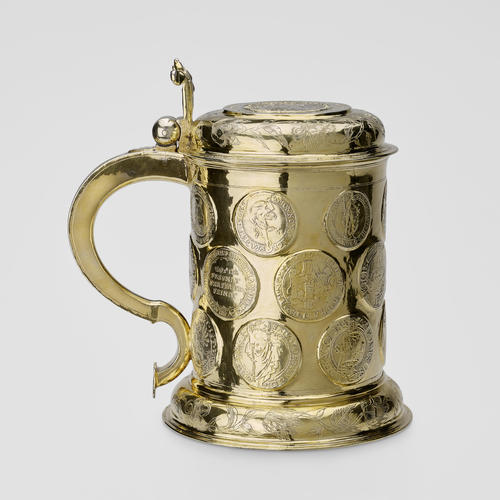
Heinrich Sadeler (active 1665)
Tankard 1665
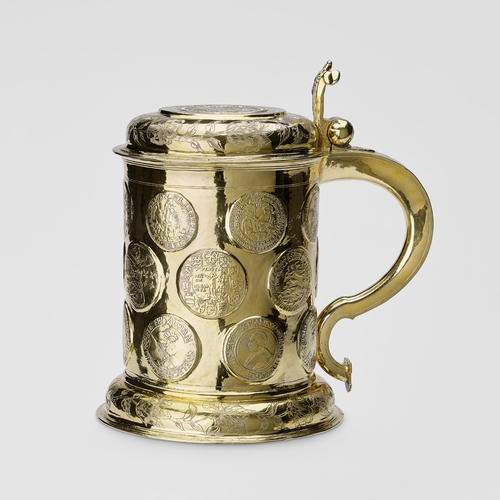
Heinrich Sadeler (active 1665)
Tankard 1665
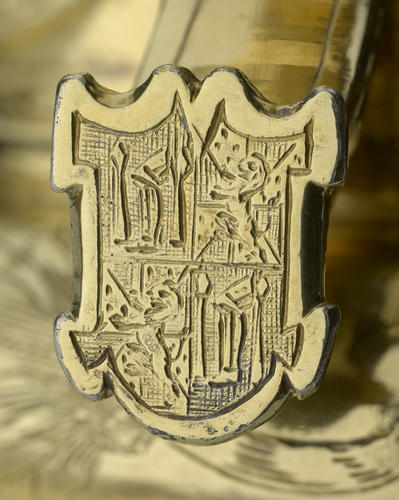
Heinrich Sadeler (active 1665)
Tankard 1665

Heinrich Sadeler (active 1665)
Tankard 1665
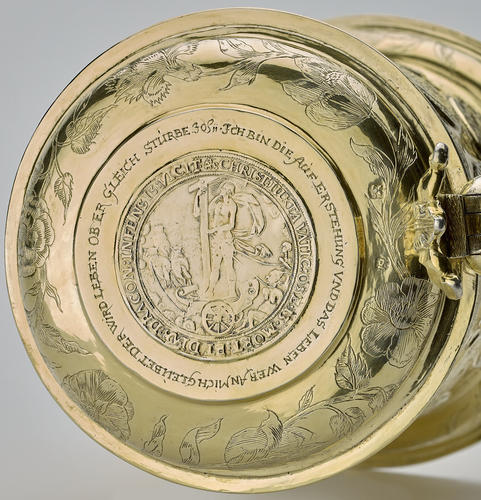
Heinrich Sadeler (active 1665)
Tankard 1665
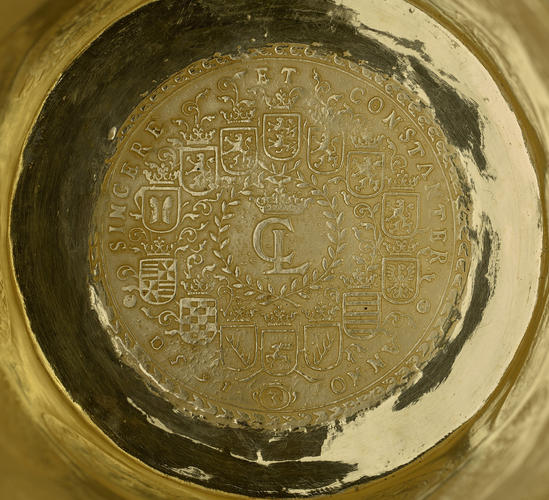
Heinrich Sadeler (active 1665)
Tankard 1665
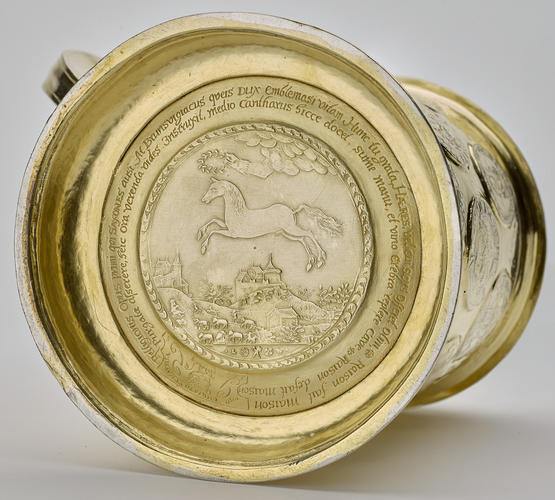
Heinrich Sadeler (active 1665)
Tankard 1665

Heinrich Sadeler (active 1665)
Tankard 1665

Heinrich Sadeler (active 1665)
Tankard 1665









-
A German silver-gilt tankard, with hinged cover, inset with a medallion of Christ Triumphant, surrounded by inscriptions in French, German, Latin and Hebrew, and with a border of engraved flowers; with foliate thumbpiece and plain scroll handle; the cylindrical body is inset with German coins and medals, on a domed foot engraved with foliage.
This tankard appears to have been commissioned by Christian Ludwig, Duke of Brunswick-Luneberg, to celebrate his family's role in the defence of Protestantism over the previous century and as a legacy for future generations to follow the cause. The coins inserted into the body of the tankard were selected as part of a deliberate iconographic scheme and relate to the history of the house of Brunswick-Luneberg and its varying fortunes. In the base is a medal commemorating Christian Ludwig himself.
The importance of the Protestant heritage of the Dukes of Brunswick-Luneberg was crucial to the Hanoverian dynasty in Britain. In 1701 the succession to the British crown was settled upon Sophia, consort to Ernest August, Duke of Brunswick-Luneberg and Elector of Hanover, as the first Protestant to hold a claim to the throne. Sophia's claim trumped forty-two claimants to the title not through seniority but purely by virtue of her Protestantism. Thus she became the bridge between the two territories and entitled her eldest son, George, to become Elector of Hanover and King of Britain.
The tankard is one of the very few works by a Hanoverian goldsmith in the collection. Little is known of its maker, Heinrich Sadeler.
Struck on lid and upper body with mark of Hanover and maker's mark of Heinrich Sadeler; maker's mark repeated on foot.
Lid engraved: ICH BIN DIE AUFERSTEHUNG UND DAS LEBEN WER AN MICH GLEUBET DER WIRD LEBEN OBER GLEICH STURBE ('I am the resurrection and the Life - whoever believes in Me, shall live though he were Dead')
Inside lid engraved in Hebrew: ('Go and eat thy bread in joy and drink your wine with good heart, for the Almighty has already favoured your actions.')
Medal:
GEORG:EQ:DRACONEM INCOLAS SILEAE INFESTANTEM SUPERAVIT ('George the Knight has conquered the dragon which infested the inhabitants of Silea')
With GR and motto, PRO CHRISTO ET PATRIA.
Engraved around coin in base:
Religionis oopus primi qui SAXONES ausi At Brunsvigiacus queis DUX emblemasi vitam Hunc tu grata, HAERES, vel cui sors Offeret olim. Purgatae asserere heic ora verenda vides Instruxit, medio Cantarus hicce docet Sume menu, et vino crebra replerere cave. ('The first Saxons desired a work of religion, but the duke of Brunswick [gave] them a life of fine craftsmanship. This vessel, thou heir by grace, or to whom fate should offer it at some time. The purified [female] ones protected thou seest hereupon faces [that are] to be feared, this very bowl has organised')
Raison fait maison / Raison defait maison ('Reason builds a house / Reason tears a house down').
Tankard inset with:
Frederick III (the Wise), Elector of Saxony (1463-1525), Johann I (the Steadfast), Elector of Saxony (1468-1532) and George, Duke of Saxony (1471-1539): 'klappmützentaler'.
Johann (the Steadfast), Elector of Saxony and George, Duke of Saxony: taler.
Stephan Schlick (1487-1526) and his brothers: taler (1520-5).
George, Duke of Saxony: taler (1530).
Gustav Vasa of Sweden (1496-1560): daler (1547).
Henry Julius, Duke of Brunwick-Lüneburg (1564-1613): 'truth taler' (1597).
'Wasp taler' (1599).
Peace taler (1599).
Madgeburg city taler (1617).
Christian, Duke of Brunswick-Lüneburg, Bishop of Halberstadt (1599-1626): taler (1622).
Frederick Ulrich of Brunswick-Lüneburg (1591-1634): taler (1633-4).
Christian IV of Denmark: speciedaler (1646), Glückstadt mint.
Queen Christina of Denmark (1626-89): riksdaler (1641-53).
Base inset with:
Christian Ludwig, Duke of Brunswick-Lüneburg (1622-65): three taler (1650), Clausthal mint, mint master Lippold Wefer.Provenance
First recorded in the collection in 1819 when it was received at Carlton House by the inventory clerk, Benjamin Jutsham. Jutsham wrote a thorough description of the piece into the ledgers, including a full list of the coins and a translation of the texts from French, German, Latin and Hebrew. Jutsham noted that the object came from Buckingham House, where it may have been part of the collections of Queen Charlotte.
-
Creator(s)
(goldsmith)(nationality)Acquirer(s)
-
Medium and techniques
Silver gilt inset with coins
Measurements
21.8 x 19.5 x 14.8 cm (whole object)
1439.2 g (Weight) (whole object)
Category
Bibliographic reference(s)
EAJ : Jones, E.A., 1911. The Gold and Silver of Windsor Castle, Letchworth p. 62, pl. XXXIII
Place of Production
Hanover (city) [Germany]